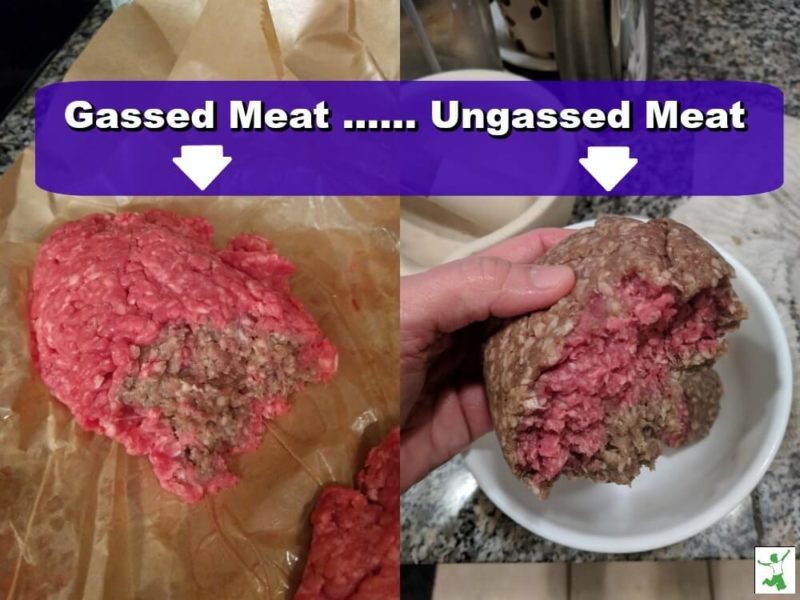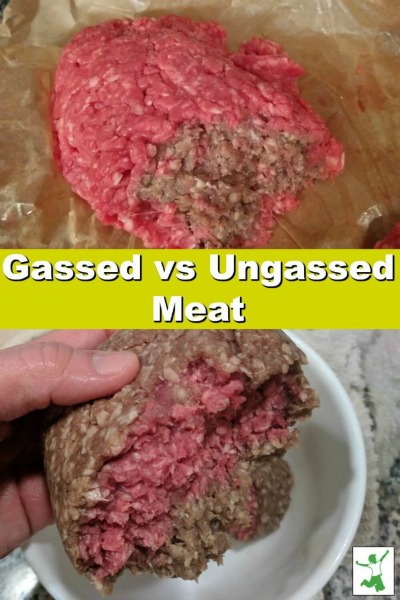How Stores Keep Ground Beef Red

Observation can be a very important tool when one embarks on the modern adventure known as supermarket shopping. Have you ever stopped to notice how everything in a supermarket and chain healthfood stores is so perfectly in its place, colorful and alluring? Even at the meat counter where variation should exist, every single package of supermarket meat is uniformly bright red.
If you've ever taken someone from a foreign country into a supermarket in the United States for the very first time, you know the kind of reaction I'm talking about.
Shock and Awe.
But things aren't always as they appear, are they?
Bright Red Supermarket Meat
Case in point. Have you ever wondered why the supermarket meat display case isalways bright red? Could it be that every package on display was freshly butchered that day?
If you've talked to a supermarket meat manager before or have a butcher in the family, you know this is simply not the case. While some new cuts are put out every day, many of the meat packages have been sitting in the display case for two, three, four days or even longer.
Most consumers never stop to wonder about this, but anyone who has ever purchased meat from a small farm or a local butcher knows that this is not a natural occurrence. Once meat becomes exposed to air, oxidation begins which gradually turns the red color of the meat to a more unappetizing brown or grey color within just a few days.
This never seems to happen to supermarket meat, does it? The meat is uniformly red not various shades of red, brown and grey which would be truly reflective of when the meat department put each package in the display case.
What's really going on here?
Carbon Monoxide Keeps Meat Red Even if It's Spoiled
The fact is that as much as 70 percent of meat sold in stores is treated with carbon monoxide to keep the meat a deceptively fresh looking red color.
Carbon monoxide is an odorless, colorless, poisonous gas that is almost impossible to see, taste or smell. It is emitted from car exhaust pipes, gas-powered lawn mowers, chimneys, gas stoves (if not used properly), unvented space heaters, and charcoal grills.
The industrialized meat industry (aka Concentrated Animal Feeding Operations – CAFO) insists that treatment with carbon monoxide, called "modified atmosphere packaging" (MAP), is necessary due to the difficulty of keeping meat at the proper temperature while in grocery store coolers.
The internal temperature of retail meat is not supposed to exceed 39° Fahrenheit (4° Celsius) at any time. An increase of just a degree or two can result in an enormous increase in bacterial growth. For example, raising the temperature from 28°F (-2° C) to 29°F (-1.5° C) can cut the shelf life of meat in half.
The problem stems from ultraviolet light from the grocery store display lights heating up the surface temperature of the meat much higher than the thermometer reading in the display case. This occurs due to the penetration of the UV light into the meat packaging similar to how our skin can burn even on a very cold day when the sun is shining.
Due to the struggles with temperature consistency, atmospheric packaging was developed. When meat is exposed to carbon monoxide, it reacts with the myoglobin in the blood giving the meat a bright red color. Fresh beef is naturally red, and as it ages, it becomes brown or grey. The carbon monoxide keeps it looking artificially fresh for up to a full year by restricting the growth of bacteria that proliferate from the increased heat of supermarket meat display cases.
 Is Carbon Monoxide Dangerous if Ingested?
Is Carbon Monoxide Dangerous if Ingested?
Carbon monoxide is fatal if inhaled in large amounts because the CO molecule attaches to hemoglobin in the blood and replaces oxygen in the bloodstream. Even minor exposure can cause fatigue, headaches, and confusion. Increasing exposure leads to unconsciousness and then death. Individuals who are fortunate enough to survive poisoning with carbon monoxide frequently continue to suffer from neurological problems.
Despite the danger, consumer groups have been unsuccessful in recent years to stop the deceptive practice of treating supermarket meat with carbon monoxide.
True to form, the industrialized meat industry says that, unlike inhalation, carbon monoxide is not harmful when it is ingested via meat treated with atmospheric packaging. Industry also insists that MAP is necessary to keep meat affordable as consumers won't buy brown meat even if it's still fine to eat causing meat that is perfectly good for sale to be thrown out unnecessarily.
Ann Boeckman, a lawyer with a legal firm for the meat industry, says consumers needn't worry about fake red supermarket meat.
"When a product reaches the point of spoilage, there will be other signs that will be evidenced–for example odor, slime formation and a bulging package–so the product will not smell or look right."
Don't you feel so much better after reading that statement?
No worries about supermarket meat that looks fresh when it's not. You'll know there's a problem by the bad smell and the slimy feel of rotting meat even though it still looks bright red and ready to throw on the grill.
Just keep buying that fake red supermarket meat (along with the fake pink sustainable salmon) and stop complaining, ok? It's cheap, right? That's all that is supposed to count for us consumers anyway!
Where to Find Healthy Grassfed Meats
If this sounds ridiculous to you as it does to me and the lure of cheap food is just a little less appealing after reading this article, consider a switch to small farm produced, grass-fed meats by clicking here. Online shopping for quality meat has now gone mainstream and is a fantastic way to get quality meat shipped to your door to bypass local supermarkets.
Alternatively, you can spend a few dollars and have a copy of the Weston A. Price Shopping Guide mailed to you and let your fingers do the walking to find a safe source of quality meat for your family that is surprisingly affordable.
As always, a quality locally owned butcher shop where they grind the meat fresh for every customer who comes through the door is an excellent way to go. A local butcher near me is the source of the ungassed meat picture above. By comparison, the gassed "grassfed" meat is from Whole Foods.
References
(1) Carbon Monoxide: Masking the Truth About Meat?
(2) We're Eating What? 9 Contaminants in US Meat
(3) Carbon monoxide keeps meat red longer; is that good?
(4) Carbon Monoxide Added to Meat Inhibits Bacteria Growth
Source: https://www.thehealthyhomeeconomist.com/why-supermarket-meat-is-always-unnaturally-red/
0 Response to "How Stores Keep Ground Beef Red"
Post a Comment